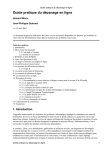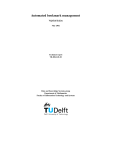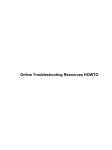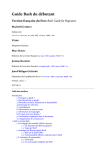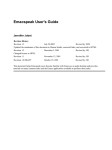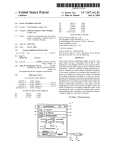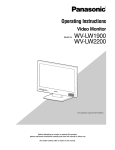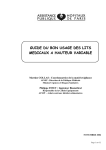Download Online Troubleshooting Resources: HOWTO
Transcript
Online Troubleshooting Resources: HOWTO Jean−Philippe Guérard Version 1.7 2006−05−25 Revision History Revision 1.7 2006−05−25 Revised by: JPG Two updates following suggestions of Oguz Yarimtepe (the Basic Unix Tutorial of Idaho State University is not available anymore, update of the link to the Why use Google page). Added a section listing translations of this document. Revision 1.6 2005−08−06 Revised by: JPG Added FOLDOC (thanks to Howard Mann for suggesting this). General document update and cleanup. Added the text of the Open Publication Licence at the end of the document. Revision 1.5 2002−10−20 Revised by: JPG More dead links removal & URL updates. Author and copyright updated as per Horward Mann request. Revision 1.4 2002−03−04 Revised by: JPG Dead links removal. Outdated links update. Revision of the HOWTOs and FAQs sections. Revision 1.3 2000−07−24 Revised by: HM Update. Revision 1.2 1999−11−20 Revised by: HM Added "Introduction to Unix" to Unix section. Revision 1.1 1999−11−08 Revised by: HM Added Geocrawler.com to Mailing List Section. Convert to DocBook. Revision 0.5 1999−09−18 Revised by: HM Initial release. Troubleshooting a Linux−related issue is often perceived as a difficult task. But, often, the solution is just a few clicks away on the internet. This document will direct Linux users to resources available on the Internet that provide access to a vast amount of Linux−related information useful in the troubleshooting problems. Online Troubleshooting Resources: HOWTO Table of Contents 1. Introduction.....................................................................................................................................................1 1.1. Document Updates............................................................................................................................1 1.2. Copyright and License......................................................................................................................1 1.3. Feedback and Corrections.................................................................................................................1 1.4. Translations.......................................................................................................................................2 1.5. Document history..............................................................................................................................2 2. Frequently−Asked−Questions (FAQs)..........................................................................................................3 3. Online Support Sections.................................................................................................................................4 4. Internet Search Engines.................................................................................................................................5 4.1. Google.com.......................................................................................................................................5 5. Usenet Newsgroup Archives...........................................................................................................................6 6. Mailing List Archives.....................................................................................................................................7 7. HOWTOs.........................................................................................................................................................8 8. Online User's Manuals...................................................................................................................................9 9. Online Unix References and Tutorials........................................................................................................10 10. Miscellaneous Resources............................................................................................................................11 10.1. Release Notes and Available Documentation related to the X Window Server...........................11 10.2. GNU Software and Manuals.........................................................................................................11 10.3. The Free On−line Dictionary of Computing.................................................................................11 10.4. An online dictionary of computer and technology terms..............................................................11 11. Concluding Comments...............................................................................................................................12 A. Open Publication License............................................................................................................................13 A.1. Requirements on both unmodified and modified versions....................................................................14 A.2. Copyright...................................................................................................................................................15 A.3. Scope of license..........................................................................................................................................16 A.4. Requirements on modified works............................................................................................................17 A.5. Good−practice recommendations............................................................................................................18 A.6. License options..........................................................................................................................................19 i 1. Introduction The traditional means of troubleshooting computer−related problems involves consulting user's manuals, books, friends − probably enticed with goodies − and, when all the former do not yield a solution, calling the technical support service of the vendor of the product in question. And, we all know pleasant and reliably efficacious the latter stratagem is. Unfortunately, this is the norm in the sphere of commercial proprietary products. In contradistinction, Linux, and related distributions, utilities and applications software, have largely been developed according to the Open Source model, wherein developers have used electronic communication over the Internet − typically in the form of publicly−accessible Mailing Lists − to collaborate with their peers in the refinement of the associated source code. Such collaboration has also traditionally involved the online publication of user's manuals, lists of Frequently−Asked−Questions (FAQ's), knowledge bases, release notes, formal guides such as this document (HOWTO's) and tutorials. In addition, users often assist others through the forum of Usenet and other newsgroups and the posted messages are readily accessible in the form of searchable archives. These Linux−related newsgroups are renowned for their high level of user participation. In significant measure, Linux may be considered a product of the Internet. Considered together, these resources enable access to a large, ever−expanding factual database, and my intent is to encourage and direct the reader to utilize these repositories when faced with an issue not addressed in the documentation that is included with each distribution of Linux. Linux veterans who assist newcomers through the forum of Usenet soon become aware of the frequency with which certain technical questions are repeatedly posted − questions the answers to which are readily available in one or more of the existent online repositories. So, to diminish the likelihood of being "flamed" in response to your posted question on Usenet or irc, read further! Armed with a browser, Linux users may rapidly become adept at troubleshooting their systems. The key is knowing how and where to look. My objective is to guide the user − particularly the Linux newbie − in this quest. 1.1. Document Updates The latest version of this document will always be available at the Linux Documentation Project. The document will also be available in SGML, PS, PDF, and other formats at that website. 1.2. Copyright and License Copyright © 1999−2005, by Jean−Philippe Guérard. This material may be distributed only subject to the terms and conditions set forth in the Open Publication Licence, v1.0 or later (see Appendix A). 1.3. Feedback and Corrections I always welcome feedback and constructive criticism. You can reach me at <jean DASH philippe DOT guerard AT tigreraye DOT org>. In particular, I wish to be notified about any errors in this document and resources you believe deserving of inclusion, but not presently covered herein. Because the assessment of the value of a particular resource is inherently subjective, I do not guarantee that I will include it, but I will certainly give any suggestion thoughtful consideration. In anticipation, Thanks. 1. Introduction 1 Online Troubleshooting Resources: HOWTO 1.4. Translations This document has already been translated in several languages. If you have made a translation of this document, please e−mail me and I will add your translation to this list. • A French translation has been made by Benoît Sibaud, of the Traduc.org project. • A Turkish translation has been made by Oguz Yarimtepe, of the docs.comu.edu.tr project. 1.5. Document history Howard Mann conceived and formulated the first version of this HOWTO. He kept managing and updating it until version 1.3. Maintainership was then taken over by Jean−Philippe Guérard, who is now in charge of this document. 1. Introduction 2 2. Frequently−Asked−Questions (FAQs) Users of Internet Newsgroups and Mailing lists soon discovered that some basic questions were being asked over and over again. To provide an answer to these questions, and to avoid them being repeated continually, FAQs were developed, listing the most classical questions and their agreed answers. A list of FAQs is also a traditional accompaniment to Linux−related software. The FAQ is the first document to peruse when troubleshooting a particular application. It provides answers to typical questions, and is a good place to start troubleshooting a specific problem. In addition, FAQs exist for Linux distributions, window managers, and the so−called desktop environments (KDE and Gnome). A FAQ is typically provided online by the developers of the product in question, and enterprising users sometimes host an "unofficial" FAQ as well. Search for the latter with an Internet search engine. For Linux newbies, I provide links to two FAQs that collectively address many of the questions posted to the Usenet newsgroups: • The Linux FAQ • The Linux Kernel mailing list FAQ 2. Frequently−Asked−Questions (FAQs) 3 3. Online Support Sections These sections are typically found at the websites of Linux distributions, and often contain a variety of helpful documents with information not easily encompassed within a FAQ. This is the second place to go when troubleshooting a problem. Look for sections with one or more of the following titles: • Installation Support • Knowledge or Solutions Databases • Tips and Tricks • Errata, Fixes and Updates • Security Information • Bug Tracking System • Bug Database • Hardware Guide or Compatibility List • Technical Guides • White Papers Some websites provide a site search engine that will facilitate your quest for a solution. If you have a problem with a newly installed distribution, look here first as bugs and their fixes are typically posted here. You may find a detailed guide that will help you accomplish a task such as upgrading your kernel or the version of the X Window System you are using. I have often been able to solve problems with my Linux distribution by looking into the bug report database, and finding that another user already has offered a solution to this issue. I recommend you spend some time at the website of the distribution you are using, familiarizing yourself with what is available. 3. Online Support Sections 4 4. Internet Search Engines I frequently use a Search Engine to retrieve helpful or necessary information from the 'net. These engines catalogue pages from commercial, personal and academic websites, as well as Mailing Lists and the like. There are several good search engine. It is worthwhile becoming very familiar with the operational details of at least one non−directory engine to maximize the efficiency and efficacy of your search efforts. You probably already have a favorite − I like Google.com, and will discuss it in a little more detail. The key to a successful search is to use a good set of keywords. If you're getting a specific error message, you might search for its text. Otherwise, you need to find a few relevant words describing your problem. Then, by trial and error, you should be able to find some pertinent information. 4.1. Google.com This engine has several novel features that are described in its Google Technology page. In particular, the engine often returns the most useful pages first; in fact, I have often found that the first listed page contains the information I need. Because it caches web pages, it is relatively fast at displaying requested items. It has a so−called GoogleScout" feature, activated by clicking on the "similar pages" links, that provides additional relevant links with each item returned. 4. Internet Search Engines 5 5. Usenet Newsgroup Archives The ability to search for and retrieve information from archived posts to the Linux−related (Usenet) newsgroups represents a powerful means of troubleshooting in Linux. Search engines permit one to search the archives by stipulating the forum, keywords, authors, dates, language and combinations thereof. Because the number of Linux−related newsgroups is large, the likelihood of finding useful information is high. The main web site that currently provides access to Usenet archives using a search engine is http://groups.google.com. The most effective way to do a search is to use its Advanced Groups Search page. I would like to relate a brief anecdote to demonstrate the efficacy of this approach. The first time I attempted to build a kernel, I was presented with this error message when I invoked a "make" command: make[1]: as86: Command not found make[1]: *** [bootsect.o] Error 127 make[1]: Leaving directory `/usr/src/linux/arch/i386/boot' make: *** [zImage] Error 2 I had no idea what as86 was, but I entered it as the keyword in the Subject field of the Advanced Groups Search page at groups.google.com, and was presented with a large number of posts from folks who had encountered the same problem. Respondents had provided the reason and solution: I did not have an assembler/linker necessary to create machine code, and the bin86 package provided it. I downloaded and installed a RPM package of the latter and was on my way. This entire process took about 10 minutes! 5. Usenet Newsgroup Archives 6 6. Mailing List Archives As you might expect, there are a very large number of Linux−related Mailing Lists that enable developers and users to communicate and collaborate on projects. These Lists cover every conceivable aspect of Linux, from the technical arcana of kernel development to the relatively unfocused discussion of issues at the newbie level. Subscribers to a particular Mailing List are generally very knowledgeable in the List's topic, and detailed and useful information is often retrievable. The communications are publicly accessible through Internet search engines and in the form of online Mailing List Archives. You will typically see archived pages when you conduct a search using an Internet search engine. Usually, you will not need to look directly in a Mailing List Archive. Search engines like Google.com include these archives in their databases. If you can't find anything with a search engine, it might be worthwhile to browse or search in an appropriate Mailing List. Also, not all Mailing Lists are associated with an online archive, but this is increasingly the case. Similarly, not all archives have an associated search engine. Initially, try locate the Mailing List Archive you are interested in by typing keywords and "mailing list archive" in an Internet search engine. You may also find Mailing List archives at the following locations: • The website of the distribution of Linux you use. • The website of the Window Manager or Desktop Environment you use. • The website dedicated to the application or project in question. • The Mail Archive • Mailing List Archives This is not a complete listing of archives and you may find additional sites with an Internet search engine. But, this should certainly get you going. 6. Mailing List Archives 7 7. HOWTOs HOWTOs are detailed reference documents on a specific subject, usually following a step−by−step approach. A HOWTO is a good document to help you discover a task or a topic you don't know. It will provide you with the basic steps and the major references. These documents are particularly useful when you decide to provide or access a new service with your Linux system, or when you embark on a technically complex project. For example, you may have the option of accessing the 'net with a DSL or Cable Modem service − excellent guides are available in the form of HOWTOs. Authors of these documents often include references and links to sites that they have found useful. You may find the information you need at one of these hyperlinked sites rather than in the HOWTO itself. To find HOWTOs, the first place to go is the Linux Documentation Project (LDP). The LDP includes a HOWTO Index Page that I suggest you bookmark in your browser. These HOWTOs are written by Linux users and are periodically updated by the authors. Many authors provide the latest version at a personal website and a hyperlink to the latter is typically provided in the document. This version may be newer than the one available at the LDP website. Note also that other HOWTOs are available, the authors of which have not submitted them to the LDP. It is definitely worthwhile trying to find these with an Internet search engine, using the "howto" keyword. 7. HOWTOs 8 8. Online User's Manuals Some of the major Linux distributions, Window Managers and Desktop Environments publish their user's manual online. If the entire manual is not online, installation and configuration guides are typically found at the relevant website. This also applies to major applications like the Gimp (GNU Image Manipulation Program) or Apache. So, for those users who do not have the printed manual, a wealth of installation and configuration guidance is generally available online. 8. Online User's Manuals 9 9. Online Unix References and Tutorials As Linux is a Unix−like operating system, a general familiarity with fundamental Unix concepts such as the Unix directory hierarchy and file permissions is essential. Fortunately, there are many Unix tutorials online that collectively cover everything a user might need to know to use Linux. I suggest you bookmark the following as an online reference library: • The Wikipedia Unix article is a good place to start. It includes an Unix history, explains some Unix concepts and includes an explanation of basic commands and some relevant links. • Eric S. Raymond's The Unix and Internet Fundamentals HOWTO is a good document to learn about the Unix concepts. • The UNIX Tutorial for Beginners of the University of Surrey is a good step by step tutorial for beginners. • The Command and Shell User's guide from Digital Equipment Corporation is an excellent guide to the Unix Operating System. Bookmark the Index Page linked there as an online reference. • UNIXhelp is mirrored on many servers around the world. It is a useful resource for newbies. • Introduction to Unix also contains a useful Unix Command Summary page with brief, but useful, explanations of commonly used Unix commands. • Unix is a Four Letter Word... is another resource suitable for newbies. 9. Online Unix References and Tutorials 10 10. Miscellaneous Resources In this section, I provide a number of links to websites that I have found useful while learning to use Linux. This is an eclectic collection, but keep these handy. 10.1. Release Notes and Available Documentation related to the X Window Server Depending on the X Window Server your distribution is using, you will need to look at either the XFree86 website or the X.Org Foundation website. Whenever you have trouble with your X environment, peruse the notes applicable to your videocard and chipset. These typically provide details about the configuration of the X Window System relative to your card, and will enumerate any "options" you have to include in the XF86Config file that governs X. 10.2. GNU Software and Manuals Many important programs that are frequently utilized by the Linux user are GNU utilities − for example, the tar (archive) and gzip (compression) programs. Descriptions of these programs are located at the FSF Free Software Directory where many Online Manuals may also be found. These manuals typically provide a lot more information than is found in the corresponding man page on your system. For example , compare the man page and online manual for the tar utility. 10.3. The Free On−line Dictionary of Computing The Free On−line Dictionary of Computing (FOLDOC) is a huge encyclopedia of computing terms and concepts, maintained by Denis Howe. It has very detailed articles, with a lot of cross references. It's a very good reference to understand anything related to computing. 10.4. An online dictionary of computer and technology terms The PC Webopedia consists of a large online dictionary of computer−related terms and a search engine that provides links to documents that discuss each item in more detail. For example, I used this site to learn the differences between ISA and PCI buses. 10. Miscellaneous Resources 11 11. Concluding Comments If you are a Linux newbie, you may want to create a Troubleshooting folder in your browser's bookmark list, into which you put the hyperlinks I have included in this document, as well as those pertinent to the distribution of Linux and the Window Manager or Desktop Environment you use. As you use these links, you will quickly become adept at troubleshooting online. Cheers and happy searching! 11. Concluding Comments 12 A. Open Publication License v1.0, 8 June 1999 A. Open Publication License 13 A.1. Requirements on both unmodified and modified versions The Open Publication works may be reproduced and distributed in whole or in part, in any medium physical or electronic, provided that the terms of this license are adhered to, and that this license or an incorporation of it by reference (with any options elected by the author(s) and/or publisher) is displayed in the reproduction. Proper form for an incorporation by reference is as follows: Copyright (c) <year> by <author's name or designee>. This material may be distributed only subject to the terms and conditions set forth in the Open Publication License, vX.Y or later (the latest version is presently available at http://www.opencontent.org/openpub/). The reference must be immediately followed with any options elected by the author(s) and/or publisher of the document (see section VI). Commercial redistribution of Open Publication−licensed material is permitted. Any publication in standard (paper) book form shall require the citation of the original publisher and author. The publisher and author's names shall appear on all outer surfaces of the book. On all outer surfaces of the book the original publisher's name shall be as large as the title of the work and cited as possessive with respect to the title. A.1. Requirements on both unmodified and modified versions 14 A.2. Copyright The copyright to each Open Publication is owned by its author(s) or designee. A.2. Copyright 15 A.3. Scope of license The following license terms apply to all Open Publication works, unless otherwise explicitly stated in the document. Mere aggregation of Open Publication works or a portion of an Open Publication work with other works or programs on the same media shall not cause this license to apply to those other works. The aggregate work shall contain a notice specifying the inclusion of the Open Publication material and appropriate copyright notice. SEVERABILITY. If any part of this license is found to be unenforceable in any jurisdiction, the remaining portions of the license remain in force. NO WARRANTY. Open Publication works are licensed and provided "as is" without warranty of any kind, express or implied, including, but not limited to, the implied warranties of merchantability and fitness for a particular purpose or a warranty of non−infringement. A.3. Scope of license 16 A.4. Requirements on modified works All modified versions of documents covered by this license, including translations, anthologies, compilations and partial documents, must meet the following requirements: 1. The modified version must be labeled as such. 2. The person making the modifications must be identified and the modifications dated. 3. Acknowledgement of the original author and publisher if applicable must be retained according to normal academic citation practices. 4. The location of the original unmodified document must be identified. 5. The original author's (or authors') name(s) may not be used to assert or imply endorsement of the resulting document without the original author's (or authors') permission. A.4. Requirements on modified works 17 A.5. Good−practice recommendations In addition to the requirements of this license, it is requested from and strongly recommended of redistributors that: 1. If you are distributing Open Publication works on hardcopy or CD−ROM, you provide email notification to the authors of your intent to redistribute at least thirty days before your manuscript or media freeze, to give the authors time to provide updated documents. This notification should describe modifications, if any, made to the document. 2. All substantive modifications (including deletions) be either clearly marked up in the document or else described in an attachment to the document. 3. Finally, while it is not mandatory under this license, it is considered good form to offer a free copy of any hardcopy and CD−ROM expression of an Open Publication−licensed work to its author(s). A.5. Good−practice recommendations 18 A.6. License options The author(s) and/or publisher of an Open Publication−licensed document may elect certain options by appending language to the reference to or copy of the license. These options are considered part of the license instance and must be included with the license (or its incorporation by reference) in derived works. A. To prohibit distribution of substantively modified versions without the explicit permission of the author(s). "Substantive modification" is defined as a change to the semantic content of the document, and excludes mere changes in format or typographical corrections. To accomplish this, add the phrase `Distribution of substantively modified versions of this document is prohibited without the explicit permission of the copyright holder.' to the license reference or copy. B. To prohibit any publication of this work or derivative works in whole or in part in standard (paper) book form for commercial purposes is prohibited unless prior permission is obtained from the copyright holder. To accomplish this, add the phrase 'Distribution of the work or derivative of the work in any standard (paper) book form is prohibited unless prior permission is obtained from the copyright holder.' to the license reference or copy. A.6. License options 19





















